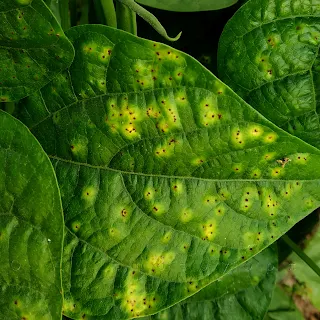Rust of Common bean
Host: Common bean (Phaseolus vulgaris L.)
Pathogen: Uromyces appendiculatus F. Strauss
Pathogen: Uromyces appendiculatus F. Strauss
Distribution
Rust of beans is most prevalent in all the beans growing regions of the
world. The disease is favored by moderate temperature in humid areas. Infection
in early season can cause heavy loss in yield as a consequence of defoliation. The
occurrence of disease was reported from Sonpipri buzurg, Maharjganj District of
India during April 2020 (author's self study).
Symptoms
 |
| Lower surface of leaf of common bean showing rust |
 |
| Upper surface of leaf of common bean showing yellow-hallo |
Symptom appear mostly
on the leaves and pods of bean. Numerous reddish-brown slightly raised spots
appear on the underside of leaves. Dust-like spore brush-off when touched with
any objects. On the upper surface tiny comparatively smaller spots appear,
which are surrounded by yellow hallo.
Pathogen
Rust of beans are caused by fungus Uromyces appendiculatus. Uromyces are the rust fungus in the family Pucciniaceae. The reddish-brown colored spots are uredosori, in which numerous uredospores are born giving rusty appearance. Towards the end season, teliospores are born, which survive in the debris and infect the plants in next season.
Control measures
- Long period of wetness with warm temperature favor the disease. Dates of irrigation should be carefully managed to avoid long period of wetness.
- Crop rotation with non-bean crops should be practiced.
- Heavy application of nitrogenous fertilizer should be avoided.
- Spray of fungicides such as, Carbendazim and Mancozeb prevent disease (Farmer’s perception in the sampling field).
Content first created on 11-06-2023
last updated on 11-06-2023
last updated on 11-06-2023


0 Comments
Leave your comments here.